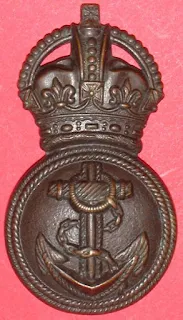Throughout its illustrious
history the Royal Navy has served ashore at various times and places, and in many capacities,
ranging from small landing parties to the Naval Brigade Siege Artillery, 24 Pdrs from HMS Shannon under
command of CAPT William Peel, present at the Relief/Siege of Lucknow and Cawnpore
during the Indian Mutiny in1857. A naval contingent also transported and served
the modified 4.7in Naval guns which aided in lifting the Siege of Ladysmith
during the Boer War. But to this author’s knowledge, it was not until World War
I that an entire military division was raised within the Royal Navy, and rushed
to the European continent in the Fall of 1914, to defense the nation of Belgium,
in stemming the invasion of that country by the German Army.
First named the Royal Naval
Division, and later re-designated The 63rd (Royal Naval) Division, it was also
referred to a “Churchill’s Private Army”, because of Sir Winston’s influence
and direction in raising the Division, as First Lord of the Admiralty. It was basically
comprised of two Naval Brigades and a Royal Marine Brigade. The Division saw
early immediate and intense action in the defense of Antwerp, Belgium
(obviously a vital port city) in the late fall of 1914. As if that baptism of
fire wasn’t enough, it was subsequently engaged in another of Churchill’s “endeavors”,
the invasion of Gallipoli in 1915, as well as gaining the Battle Honour “Somme
1916”.
The first four battalions initially
raised in the major naval depot ports of Chatham, Portsmouth, Plymouth and Deal,
and named accordingly, were quickly expanded to eight, and renamed after famous
Admirals of the Royal Navy. Those names being; Drake, Benbow, Hawke, Collingwood,
Nelson, Howe, Hood and Anson.
For the reader's convenience, examples and detailed forensic analysis of the six officially authorized cap badges of the RND battalions can be seen at; http://arnhemjim.blogspot.com/2011/08/wwi-royal-naval-division-cap-badges_28.html .
The Formation Badge of the Royal Naval Division, which was retained when the Division was re-designated The 63rd (Royal Naval) Division is depicted here:
Three immediate and vital pieces of information. The unique cap badges specific to the various named battalions were not wore by officers, warrant officers, and Chief petty officers of the Division, who retained either subdued embroidered bullion or metal cap badges. Secondly, there may have been proposed designs for a cap badge for the Benbow and Collingwood Battalions, But NONE were ever officially authorized or worn. Shoulder titles were issued for these two battalions. Thirdly, the crowned oval badge containing the letters R.N.A.S. and the profile of a Rolls Royce Amoured car, has frequently been misidentified as a cap badge, it is a collar device (“dog”), and worn as a pair on the lapels of personnel of the Royal Naval Armoured Car Squadrons. It is NOT a cap badge. The devices were worn by all ranks.
The following series of photographs depict in order;
The Royal
Naval Division, Officers Cap Badge (KC)(Bronze)(1st Pattern)
The Royal Naval Division, Officer's Cap Badge (KC)(Bronze)(1st Pattern Variant; almost appears painted)
The Royal
Naval Division, Officers Cap Badge (KC)(Bronze)(2nd Pattern)
The Royal
Navy, Officer's Cap Badge (KC)(Bullion)(1901-20)
The Royal
Navy Volunteer Reserve, Officer's Cap Badge (KC)(Bullion)
The Royal
Naval Division Chief Petty Officer's Cap Badge (KC)(Bronze)
The following are extremely scarce variant collar devices worn as an alternate on the khaki officer's service dress of the Royal Naval Air Service Armoured Car Squadrons:
Both sets of devices can be observed being worn on the lapels of the group of officers in the following photograph (Apologies, because unfortunately attribution can't be established. Will remove if so requested):














3 comments:
Interesting article and excellent photos! Were the metal cap badges showing in the first 3 images used by the RN or exclusively by the Naval Division? Tks. Jon
Hello Jon,
Thank you very much for the compliments and your interest in the blog. To the best of my knowledge the cap badges were only wore by the officers serving in the RND. Having said that, you know as well as I that like anything there may have be exceptions, but would think it would have been limited to Royal Navy officers serving ashore in active theaters of land operations.
Best regards,
Arnhem Jim
Arizona Territory
Hi Jim,
Thanks for your greetings and info. I formerly thought such badges were simply a metal equivalent of general issue RN cap insignia. Glad to know better now! Thanks again. Regs, Jon
Post a Comment